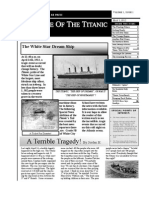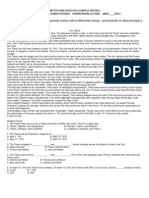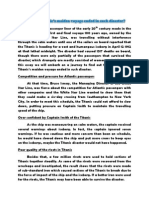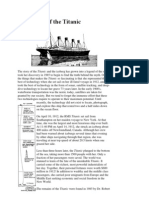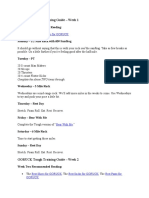Titanic
Titanic
Uploaded by
Szemők NikolettCopyright:
Available Formats
Titanic
Titanic
Uploaded by
Szemők NikolettCopyright
Available Formats
Share this document
Did you find this document useful?
Is this content inappropriate?
Copyright:
Available Formats
Titanic
Titanic
Uploaded by
Szemők NikolettCopyright:
Available Formats
Titanic...
the tragic loss of an "unsinkable" ship
One of the most famous events in history is the tragic sinking of Titanic. The ill-fated
ship sank just four days after starting her maiden voyage from Southampton in England,
killing over two thirds of the passengers on board. These events have been made into
many films, books, and television documentaries as people still try to understand just what
happened and how a ship said to be "unsinkable" could have met such a fate.
The History of the Titanic
Titanic was made by the White Star Line company, who decided to build ships to a size and
level of luxury unlike anything before. The building of Titanic began in March of 1909 in
Belfast in Ireland. There was much publicity and the ship was famous even before it was
finished as news of its chandeliers, ballrooms and passenger rooms fitted with electric lights
and heating.
When it finally set sail from Southampton to New York on April 10th, 1912 it had 2,224
passengers and crew members on board yet was only equipped with 16 lifeboats which would
only hold only 1,708 people. The White Star Line knew they should have had more but chose
not to as they didn't want the decks to look cluttered and spoil the look of the ship.
On 14th April, four days into its voyage, Titanic received five ice warnings yet failed to slow
down. When, at 11:40 at night a lookout spotted an iceberg but it was too late to turning
around and hit the iceberg. This collision ripped a 300 foot long hole in the ship
which immediately began filling the lower compartments with icy water.
It wasn't until forty-five minutes later that the first lifeboat was launched and by the time the
last boat launched there were still more than 1,500 passengers left on the sinking ship. At 2:10
AM the rear of the ship rose out of the water and due to its vast weight the ship then split into
two. Eventually Titanic completely sank. As there were not enough life jackets many
people tried to cling to anything they could find that would float. Eventually 1,522
people died from drowning or hypothermia.
When news of Titanic's distress was known the first to try and help was
Arthur Rostron, an Englishman who was at the wheel of Carpathia. He was
58 miles away from the sinking vessel, and he knew that it would take
him almost 4 hours travel this distance. He sent a message saying he was
sailing fast and hard. Even though he would have to pass through the
same dangerous, icy waters Captain Rostron did not hesitate. Carpathia
was steaming as fast as the crew could make her go but the Titanic had
gone under quickly. He and his crew were able to save some people, but
by the time they had arrived just 710 people were still alive out of 2224.
The famous Carpathia was honoured as “the Titanic rescue ship”, but in
1918 Carpathia sank after being hit by 2 torpedoes fired by a German U
boat.
The tragedy of Titanic is often referred to today as the "greatest maritime
disaster in history."
1. The White Star Line was the company that built the Titanic, and was owned by J.P.
Morgan, an American tycoon. It cost $7.5 million to build the Titanic. It was the most
luxurious ocean liner of its time. The price of a first class ticket cost each passenger $4,700
which was a HUGE amount of money for the time. It would be about $57,000 today.
2. As the Titanic was leaving the port, the suction it caused actually snapped the ropes of a
nearby docked ship, the S.S. New York. Tugboats had to race to the scene to prevent the New
York from colliding with the Titanic. Some people felt this was a bad omen.
3. There were six iceberg warnings received by Titanic on the day of the collision. They
were all ignored by the wireless operator. Unfortunately, that operator was preoccupied with
transmitting passenger messages. The night the collision occurred was moonless and the water
was still. Both of these facts made it very difficult to see into the dark night and black ocean.
The iceberg that the Titanic struck was not very big. It did not even come up as high as the
bridge of the ship.
4. The Titanic was traveling 22.5 knots. This was just .5 knot from her maximum speed
capability. The ship was clearly traveling too fast for conditions. The collision occurred at
11:40 P.M. on Sunday, April 14, 1912.
5. The captain ordered the engines reversed which sealed the Titanic's fate. A ship as large as
the Titanic turned more quickly the greater her forward motion. Had the Titanic proceeded
ahead and turned, it is most likely that she would have avoided hitting the iceberg all
together. The gash that the iceberg cut into the hull of the Titanic was between 220 to 245
feet long. The total length of the ship was approximately 882 feet. Recent evidence shows
that an opening the size of a refrigerator is what allowed water to enter the ship. Also, the
"watertight" compartments of the Titanic's hull were not actually watertight. They were open
at the tops, which made the disaster worse. The ship could have stayed afloat if only four
compartments flooded, but five actually flooded.
6. A total of 1,503 people died, including passengers and crew. Only 705 people survived.
Only 1 child from first class died, while 49 children from steerage died. Many dogs were also
aboard the Titanic. Two survived. Charles Joughin was the only person to survive the ice
cold Atlantic water.
7. Law required a ship the size of the Titanic to have 962 lifeboat seats. The Titanic had
1,178 seats, but 2,208 lifeboat seats were needed to get everyone off the ship. Many of the
lifeboats left the ship only half full. There were 472 lifeboat seats not used. Not many people
went down with the ship. Most of the people went into the Atlantic Ocean with life jackets
on. However, the water temperature was only 31 degrees, so most people froze to death in the
water.
8. The Carpathian was the ship that responded to the Titanic's distress call, but she was 58
miles and 4 hours away.
9. Orders from the Captain were that, women and children were to board the lifeboats first.
One man, Daniel Buckley, disguised himself as a woman to get aboard a lifeboat. The band
played music up to the last few minutes before the ship went under. None of the band
members survived.
10. The Titanic lies 12,600 feet at the bottom of the Atlantic Ocean. The two pieces of the
Titanic lay 1,970 feet apart from one another on the ocean floor. The Titanic was
rediscovered on July 14th, 1986, seventy-four years after it sank. Since the death of Millvina
Dean, May 31, 2009, there are no longer any living survivors of the Titanic tragedy. Millvina
Dean was just nine weeks old at the time of the Titanic's sinking.
You might also like
- BW Sixth Grade Titanic Reading Comprehension ActivityDocument3 pagesBW Sixth Grade Titanic Reading Comprehension Activityjinko100% (1)
- Hirens Boot CDDocument2 pagesHirens Boot CDStaicu Dan CostinNo ratings yet
- Passive Voice Reading TitanicDocument2 pagesPassive Voice Reading TitanicCarlos Andres CriolloNo ratings yet
- TitanicDocument23 pagesTitanicMuzan KibutsujiNo ratings yet
- The Tale of The TitanicDocument10 pagesThe Tale of The TitanicIonut VoicuNo ratings yet
- The Titanic StoryDocument2 pagesThe Titanic Storyapi-2062190670% (1)
- The Sinking of The TitanicDocument6 pagesThe Sinking of The Titanictani.speroNo ratings yet
- What Are The Causes of Titanic To SinkDocument5 pagesWhat Are The Causes of Titanic To SinkwisepupilNo ratings yet
- Final ProjectDocument23 pagesFinal Projectکمال کتابتونNo ratings yet
- Ttitanic - The Mourning of The Atlantic Waters!: The First Devastating InformationDocument2 pagesTtitanic - The Mourning of The Atlantic Waters!: The First Devastating InformationAndreeaNo ratings yet
- Titanic: © Primary JunctionDocument1 pageTitanic: © Primary JunctionSrdan PetricNo ratings yet
- Titanic Omar NewDocument8 pagesTitanic Omar Newomar.marzouk202No ratings yet
- Ttitanic - The Mourning of The Atlantic Waters!: The First Devastating InformationDocument2 pagesTtitanic - The Mourning of The Atlantic Waters!: The First Devastating InformationAndreeaNo ratings yet
- Facts About The TitanicDocument10 pagesFacts About The TitanicSimionov DanielNo ratings yet
- S I F T: Ome Nteresting Acts On The ItanicDocument2 pagesS I F T: Ome Nteresting Acts On The ItanicRamona_4ever14No ratings yet
- Leon 555Document15 pagesLeon 555Andrei Dumitru UrsuleanNo ratings yet
- Titanic: Colegiul Economic AradDocument16 pagesTitanic: Colegiul Economic AradMada Sheby100% (1)
- The TitanicDocument12 pagesThe Titanicapi-245679581No ratings yet
- The - Titanic Background PowerpointDocument18 pagesThe - Titanic Background PowerpointSarahMasseyNo ratings yet
- Short Story of The Titanic: Www.5pe Rcangol - HuDocument2 pagesShort Story of The Titanic: Www.5pe Rcangol - HuMaylin SamaniegoNo ratings yet
- Competencialing 11°Document1 pageCompetencialing 11°Nidia Yaneth CéspedesNo ratings yet
- Titanic MovieDocument2 pagesTitanic MovieLaurentiu CiobanuNo ratings yet
- How Many People Died in TitanicDocument3 pagesHow Many People Died in TitanicRifa tusnia MonaNo ratings yet
- Short Story of The Titanic: Www.5percangol - HuDocument2 pagesShort Story of The Titanic: Www.5percangol - HuMaylin SamaniegoNo ratings yet
- Into the Darkness:: The Harrowing True Story of the Titanic DisasterFrom EverandInto the Darkness:: The Harrowing True Story of the Titanic DisasterNo ratings yet
- Why Did The Titanic SankDocument3 pagesWhy Did The Titanic SankVincent Tan Ying Zheng100% (1)
- The Sinking of The Titanic: An Ice-Pilots PerspectiveFrom EverandThe Sinking of The Titanic: An Ice-Pilots PerspectiveRating: 2.5 out of 5 stars2.5/5 (1)
- TITANIC ReadingDocument2 pagesTITANIC ReadingYuliana PaolaNo ratings yet
- Titanic TragedyDocument4 pagesTitanic TragedyainasafiaNo ratings yet
- TitanicDocument4 pagesTitanicPaula AndriesNo ratings yet
- Analytical Writing - 3: Research DataDocument2 pagesAnalytical Writing - 3: Research DataHim MittalNo ratings yet
- Titanic Lesson PlanDocument12 pagesTitanic Lesson PlanDianaWeiszNo ratings yet
- The RMS Titanic Was A British Ocean LinerDocument2 pagesThe RMS Titanic Was A British Ocean LinerAngie Nayely Palomar BalcazarNo ratings yet
- Welcome To The History of The TitanicDocument12 pagesWelcome To The History of The TitanicHainer Ortega RomeroNo ratings yet
- Titanic PaperDocument3 pagesTitanic Paperapi-280068294No ratings yet
- 7-The TitanicDocument1 page7-The TitanicAnne JamesNo ratings yet
- Why The Unsinkable, Sinked in Such A Fateful Way-1Document5 pagesWhy The Unsinkable, Sinked in Such A Fateful Way-1GonNo ratings yet
- Shannon Titanic ProjectDocument16 pagesShannon Titanic ProjectCarlo SemeriaNo ratings yet
- A. Read The Passage Again and Then Answer The Questions That FollowingDocument2 pagesA. Read The Passage Again and Then Answer The Questions That FollowingTimothy Dupuy100% (2)
- Titanic - Case StudyDocument3 pagesTitanic - Case StudyJithin kvNo ratings yet
- Lessons From The Titanic Text For Reading TasksDocument3 pagesLessons From The Titanic Text For Reading TasksammaramsyarNo ratings yet
- The Sinking of The TitanicDocument1 pageThe Sinking of The TitanicOliveira SérgioNo ratings yet
- Titanic ResearchDocument4 pagesTitanic Researchapi-234432750No ratings yet
- The Incredible Quest To Find The Titantic 2Document24 pagesThe Incredible Quest To Find The Titantic 2api-18222205No ratings yet
- TitanicDocument1 pageTitanic23.shrey.kutteNo ratings yet
- Titanic, The Ship of DreamsDocument1 pageTitanic, The Ship of DreamsJonasDatBoiNo ratings yet
- One of The WorldDocument3 pagesOne of The WorldhirukihasithmaNo ratings yet
- The Legacy of The TitanicDocument8 pagesThe Legacy of The TitanicBoaz MathewNo ratings yet
- Group 10 - Titanic DisasterDocument9 pagesGroup 10 - Titanic Disastersujay nayakNo ratings yet
- The Story of TitanicDocument2 pagesThe Story of Titanicsmaaforesusua1987No ratings yet
- Titanic en InglésDocument1 pageTitanic en InglésAgos ZanellaNo ratings yet
- The Titanic GuiónDocument2 pagesThe Titanic GuiónanagallegobNo ratings yet
- TitanicDocument2 pagesTitanicAzrin AzNo ratings yet
- Lessons From The Titanic (V2)Document4 pagesLessons From The Titanic (V2)mfreak321No ratings yet
- Lessons From The TitanicDocument6 pagesLessons From The TitanicNguyên BùiNo ratings yet
- Deja Brew: The Coffee That Will Take You BackDocument27 pagesDeja Brew: The Coffee That Will Take You BackIrish ArapocNo ratings yet
- GORUCK Tough Training Guide - Week 1Document10 pagesGORUCK Tough Training Guide - Week 1Donavan WallaceNo ratings yet
- Installing The Software: Dpc/TrackDocument4 pagesInstalling The Software: Dpc/TrackElaine PuiNo ratings yet
- Difference Between Horizontal and Vertical Integration (With Example and Comparison Chart) - Key Differences 2Document1 pageDifference Between Horizontal and Vertical Integration (With Example and Comparison Chart) - Key Differences 2Quratulain Altaf HusainNo ratings yet
- Goblins of KrynnDocument2 pagesGoblins of KrynnChuck ThompsonNo ratings yet
- Brochure in ScienceDocument2 pagesBrochure in SciencePauline Joy AligwayNo ratings yet
- READING (P. 1 & 2) 1.choose The Best Option (A, B or C)Document3 pagesREADING (P. 1 & 2) 1.choose The Best Option (A, B or C)Diana HodasNo ratings yet
- Kurzweil Pc3k8Document425 pagesKurzweil Pc3k8Siro VaqueroNo ratings yet
- Flow ChartDocument3 pagesFlow ChartAna Marie FresnozaNo ratings yet
- IGH0503 HDocument11 pagesIGH0503 HOscar WaiharoNo ratings yet
- Vercels Story WIPDocument11 pagesVercels Story WIPthelavalandhopperNo ratings yet
- CHAPTER 4b PDFDocument10 pagesCHAPTER 4b PDFAt Sa Wakas AyNo ratings yet
- Taylor Swift - So Long, London Lyrics Genius LyricsDocument1 pageTaylor Swift - So Long, London Lyrics Genius Lyrics9rs22cqsptNo ratings yet
- Life Vision A1-A2 - Unit 5 - Original - 2 ChamadaDocument4 pagesLife Vision A1-A2 - Unit 5 - Original - 2 ChamadaLigiane Ferreira PortoNo ratings yet
- IP Camera WEB User ManualDocument38 pagesIP Camera WEB User Manualjoguba33No ratings yet
- X-Ray Backscatter Imaging With A Novel Twisted Slit CollimatorDocument8 pagesX-Ray Backscatter Imaging With A Novel Twisted Slit CollimatorDani AlmeidaNo ratings yet
- Global Media CulturesDocument12 pagesGlobal Media CulturesReen Bughao100% (11)
- Q1 Grade7 Music and The Integrated ArtsDocument50 pagesQ1 Grade7 Music and The Integrated ArtsNoldan King FranciscoNo ratings yet
- Lesson 3 - Unit 3-4TH GradeDocument4 pagesLesson 3 - Unit 3-4TH GradeVanessa reyes yactayoNo ratings yet
- Introduction To Data CommunicationDocument72 pagesIntroduction To Data CommunicationRaj ChauhanNo ratings yet
- NU210391064861402 EticketDocument2 pagesNU210391064861402 Eticketjoel crossNo ratings yet
- Sapin Sapin: IngredientsDocument3 pagesSapin Sapin: IngredientsYvet KatNo ratings yet
- Poetry Multiple Choice QuestionsDocument3 pagesPoetry Multiple Choice Questionszregina96No ratings yet
- 50 Ipv4 Subnetting Practice Questions (With Answer Key)Document15 pages50 Ipv4 Subnetting Practice Questions (With Answer Key)whizkidraj33% (3)
- MonstersDocument3 pagesMonstersSOO LEE TENG MoeNo ratings yet
- Dinesat Radio English 2 PDFDocument104 pagesDinesat Radio English 2 PDFGustavo CantilloNo ratings yet
- The Liedernet Archive: Rossignolet Du Bois Rossignolet SauvageDocument1 pageThe Liedernet Archive: Rossignolet Du Bois Rossignolet SauvageUMMMM NONo ratings yet
- GRADE 9 - Narrative Text 1Document14 pagesGRADE 9 - Narrative Text 1Ludfi Rusdiyono100% (1)
- The Most Dangerous GameDocument3 pagesThe Most Dangerous GameArlinda PerezNo ratings yet




